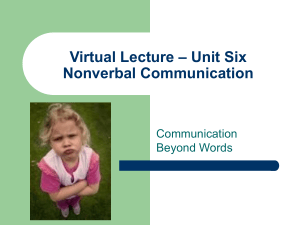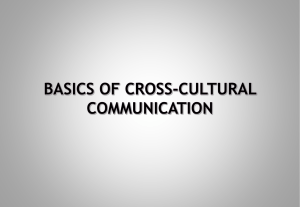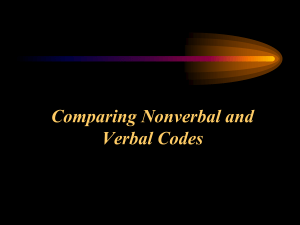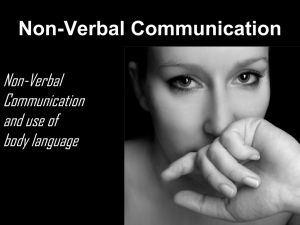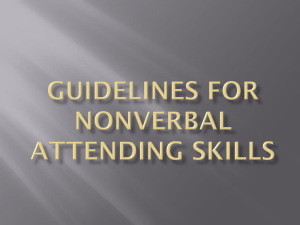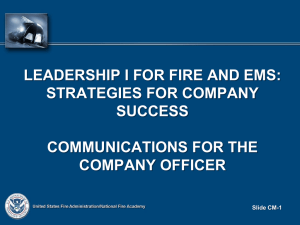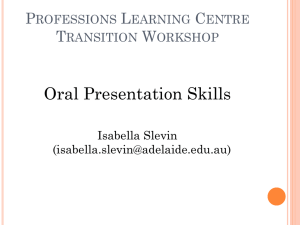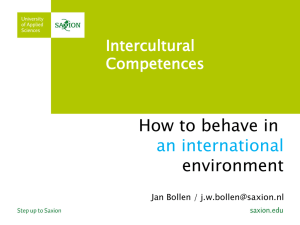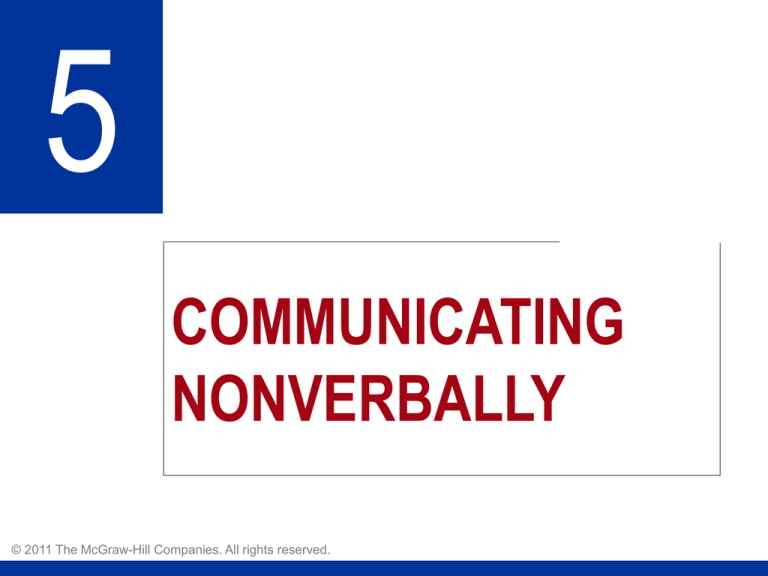
5
COMMUNICATING
NONVERBALLY
© 2011 The McGraw-Hill Companies. All rights reserved.
[What’s To Come
» The Nature of Nonverbal Communication
» Ten Channels of Nonverbal Communication
» Culture, Gender, & Nonverbal Communication
» Improving Your Nonverbal Communication
Skills
The Nature of Nonverbal
Communication
[
» Nonverbal communication includes those
behaviors and characteristics that convey
meaning without the use of words
• Some nonverbal communication behaviors
accompany words
• Other nonverbal communication behaviors
convey meaning on their own
The Nature of Nonverbal
Communication
[
The Nature of Nonverbal
Communication
[
» Nonverbal communication:
•
•
•
•
•
Is present in most communication contexts
Often conveys more than verbal communication
Is usually believed over verbal communication
Is the primary means of expressing emotion
Metacommunicates (communication about
communication, in this case, nonverbal)
• Serves multiple functions
The Nature of Nonverbal
Communication
[
» Serves multiple functions
• Helps us manage conversations
» Raise hand to speak, nod of acknowledgement
• Helps us maintain relationships
» Nonverbal signals of affection and affiliation
» Smile, wink, standing/sitting close, thumbs up
• Helps us form impressions of others
» How someone dresses, grooms, carries oneself
» May not be accurate, but we rely on the cues
The Nature of Nonverbal
Communication
[
» Serves multiple functions
• Helps us influence others
» We often manipulate visual cues such as clothing,
hairstyle, etc. to appear more authoritative or alluring
• May communicate that we are concealing
information or being untruthful
» Natural tendency to adopt a more rigid posture and
use fewer gestures
» Vocal pitch gets higher; smile may appear forced
Ten Channels of Nonverbal
Communication
[
1) Facial displays are particularly important in
three arenas
• Identity
• Attractiveness
» Symmetry
» Proportionality
• Emotion
Ten Channels of Nonverbal
Communication
[
2) Eye behaviors,
known as
oculesics,
comprise a
second nonverbal
channel
• Eye contact
• Pupil size
Ten Channels of Nonverbal
Communication
[
3) Movement and gestures:
Movement is known as
kinesics; gestures are
known as gesticulation
• Forms of gestures
» Emblems: wave hello
» Illustrators: fish was ‘this’ big
» Affect displays: surprise!…hand over mouth
» Regulators: raise hand to speak…slow down motion
» Adaptors: self=scratch itch, other=pick lint off shirt
Ten Channels of Nonverbal
Communication
[
4) The study of touch
is known as
haptics
• Affectionate touch
• Caregiving touch
• Power and control
touch
• Aggressive touch
• Ritualistic touch
Ten Channels of Nonverbal
Communication
[
5) Vocalics are aspects of the voice that
convey meaning
•
•
•
•
•
Pitch: how high or deep
Inflection: expressive vs. monotone
Volume: how loud or quiet
Rate: how fast or slow
Filler words: “umm” “er”
Ten Channels of Nonverbal
Communication
[
5) Vocalics are aspects of the voice that
convey meaning
•
•
•
•
•
Pitch: how high or deep
Inflection: expressive vs. monotone
Volume: how loud or quiet
Rate: how fast or slow
Filler words: “umm” “er”
“ya know”
Ten Channels of Nonverbal
Communication
[
Ten Channels of Nonverbal
Communication
[
5) Vocalics (cont.)
• Pronunciation: are words spoken
correctly?(“aks” vs. “ask”)
• Articulation: how well words are enunciated . . .
Is speaking clear or mumbled?
• Accent: usually geographic pronounciation
• Silence: very effective to convey seriousness;
also used when unsure of an answer
Ten Channels of Nonverbal
Communication
[
6) Olfactics is the study
of smell
• Memory: Olfactic
associations
• Romantic attraction: We
are drawn to people with
dissimilar scents – tied
to genetics differences
and reproduction
Ten Channels of Nonverbal
Communication
[
7. Proxemics is the study
of how we use space to
communicate
• Anthropologist Edward T.
Hall’s spatial zones:
» Intimate: 0 to 1.5 feet
» Personal: 1.5 to 4 feet
» Social: 4 to 12 feet
» Public: 12 or more feet
Ten Channels of Nonverbal
Communication
[
Ten Channels of Nonverbal
Communication
[
8) Physical appearance sends messages,
whether intentionally or unintentionally
• Halo effect says we attribute positive qualities to
attractive people. If someone looks good, we
are more likely to trust them
• Pressure to be attractive can lead to, or worsen,
eating disorders, and cause some people to
become obsessed with cosmetic surgery.
Ten Channels of Nonverbal
Communication
[
9) Chronemics is the
way we use time
to communicate
• Messages about
value
• Messages about
power
Ten Channels of Nonverbal
Communication
[
10) Use of Artifacts
Artifacts are the objects and visual features in
an environment that reflect who we are
Artifacts can also reflect how we wish to be
seen by others
Culture, Gender, and Nonverbal
Communication
[
» Culture influences nonverbal communication
•
•
•
•
•
Emblems: hand signals differ
Affect displays: emotional displays differ
Personal distance
Eye contact
Facial displays of
emotion: intensity differs
Culture, Gender, and Nonverbal
Communication
[
» Culture influences nonverbal communication
•
•
•
•
Greeting behavior
Time orientations
Touch
Vocalics: filler words
Culture, Gender, and Nonverbal
Communication
[
» Gender influences
nonverbal
communication
• Emotional
expressiveness
• Eye contact
• Personal space
• Vocalics
• Touch
• Appearance
Improving Your Nonverbal
Communication Skills
[
» Interpreting
nonverbal
communication
• Be sensitive to
nonverbal
messages
• Decipher the
meaning of
nonverbal
messages
Improving Your Nonverbal
Communication Skills
[
» Expressing nonverbal
messages
• Spend time with highly
expressive people
• People-watch, even if you
can’t hear what’s being
said, try to decipher what’s
being communicated
nonverbally
[Kennedy-Nixon Debate • 1960
[CNN • Nonverbal Debate • 2008
[For Review
» How do people communicate nonverbally?
» How do culture and gender influence
nonverbal behavior?
» In what ways can you improve your
nonverbal communication skills?

